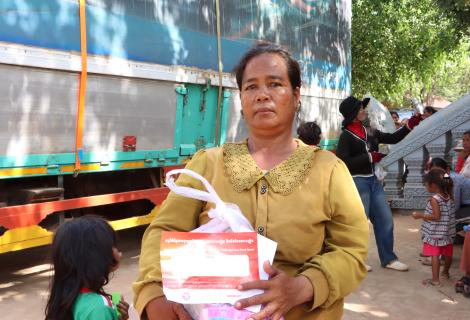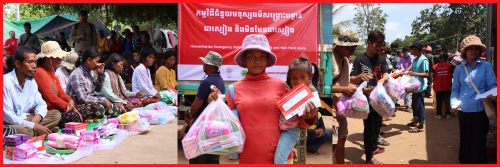From Rice Field to Refuge: A Grandmother’s Journey to Safety Amid the Cambodia–Thailand Border Clash

July 24, 2025, began like any other morning for the Cambodian villagers in Oddar Meanchey Province, not far from the Cambodia–Thailand border. The air was cool as the raining season occurs, the fields glistened with dew, and people headed out to work as they always did.
Among them was Mrs. Khea, 43, who rose in the early morning and made her way out of the village to her rice field as a usual daily routine. However, that morning’s silence did not last. As she began working, a sudden, jarring sound tore through the sky. It wasn’t thunder. It was gunfire of the clash at the sharing border line.
“My rice field is about five kilometres from the battlefield,” Khea recounted the memory, her voice trembling.
When I heard the gunshots, I was scared and didn’t go back into the village. I called my husband and told him to take our three grandchildren and meet me outside the village.
She gathered her grandchildren, and her husband stayed behind.
The four of them—a grandmother and her three young grandchildren, found themselves in the middle of a fearful, confusing situation. The armed fighting did not die down that morning, and they had no choice but to flee far away from the conflicted zone. They carried nothing with them, no extra clothes, no rice, no money.
With every step on the road, the sound of gunfire echoed behind them and flashes lit up -the sky. “We had nothing, just ourselves”, Khea said quietly. Fortunately, they met one family along the way who offered them space on a walking tractor, giving them a much-needed ride toward safety.
After a long journey, they arrived at a displacement site located inside the pagoda compound. The site was filled with displaced people, but the shelter felt strange and unfamiliar.
Before coming here [current shelter], I stayed at another safe place, but I didn’t know anyone there,” Khea explained. “A family let us stay with them even though there was not enough space for all of us. When it rained, I had no choice but to cover myself and my grandchildren with tarpaulin that I received as aid.
She continues, “I had to borrow cookware from the laywoman and people nearby to prepare food. I cooked only once a day to cover all meals because I was afraid of bothering my neighbours too much.”
The calm in the chaos happened after she was relieved by one of her children who came to bring her to the current shelter together with other relatives. Her family received multiple emergency relief assistance from many helpers and organisations including one from ActionAid Cambodia.

With the support by the International Humanitarian Action & Resilience Team (IHART), ActionAid Cambodia collaborated with the Community Translation Organization, provincial authorities, the National Committee for Disaster Management, and partners, supported over 3,500 families who were forced to flee their homes. Each family received emergency food, hygiene supplies, and cash assistance to ensure dignity and safety during this difficult time.
“This package will help sustain me for a while. There are many useful items in it, and I’m especially thankful it also includes cash,” she said.
Khea noted that this is not the first time she had to run for safety. “Actually, this is the second time I’ve fled. When the tension first started, I left home, but I went back because the situation was not this serious.”
In her quiet strength, Khea carries the weight of uncertainty, caring for her grandchildren with the hope that peace will hold, and that one day, they can return home. “I am happy to hear about the ceasefire because when I fled, I had to leave the poultry, home and everything behind”.
Khea and her family were among thousands of people and children whose lives were disrupted. They had to leave their usual livelihoods and schools to seek shelter, with no choice but to stay in collective refuges where they shared bathrooms, toilets, and even sleeping spaces.
According to the Cambodia National Committee for Disaster Management (NCDM), as of July 30, approximately 172,000 people have been displaced and are currently taking shelter across five provinces: Siem Reap, Oddar Meanchey, Banteay Meanchey, Preah Vihear, and Pursat.